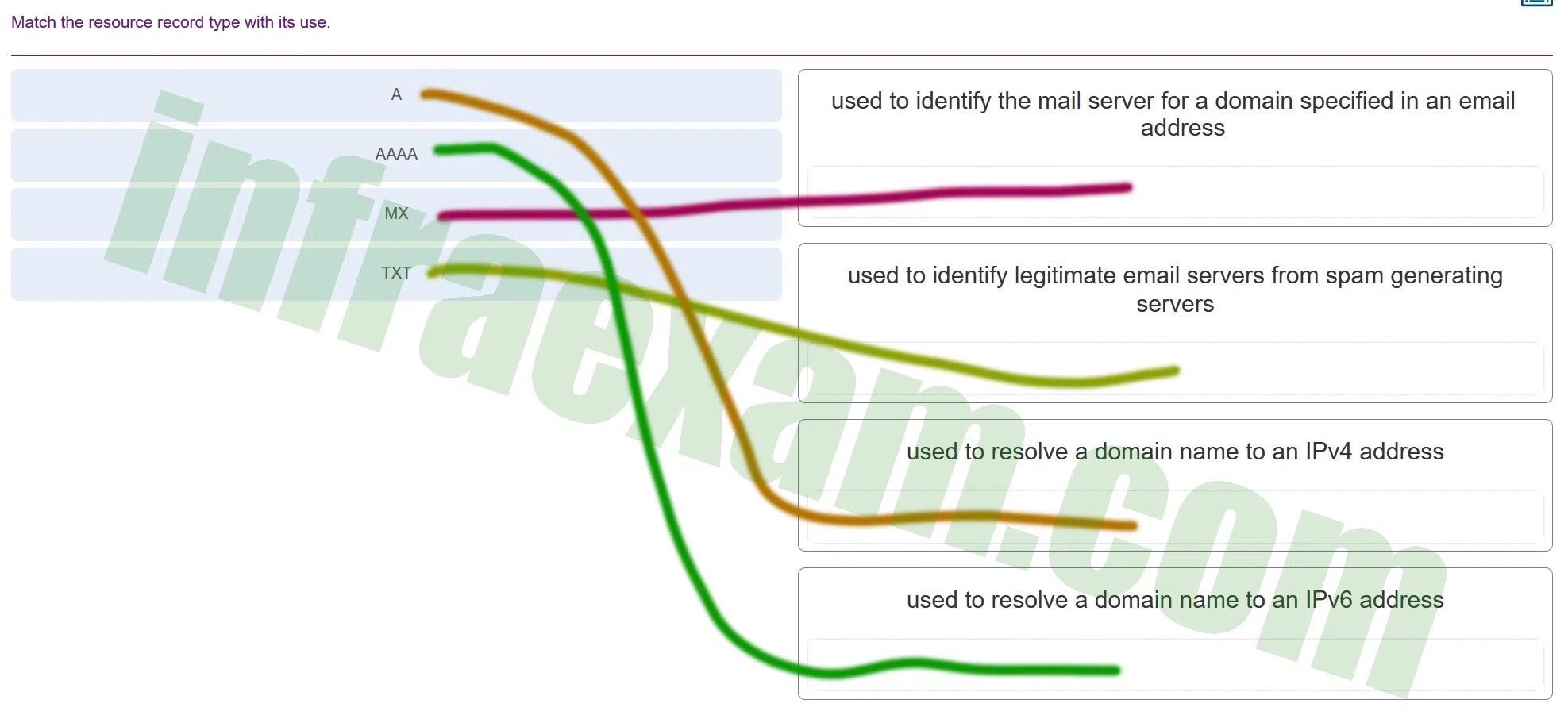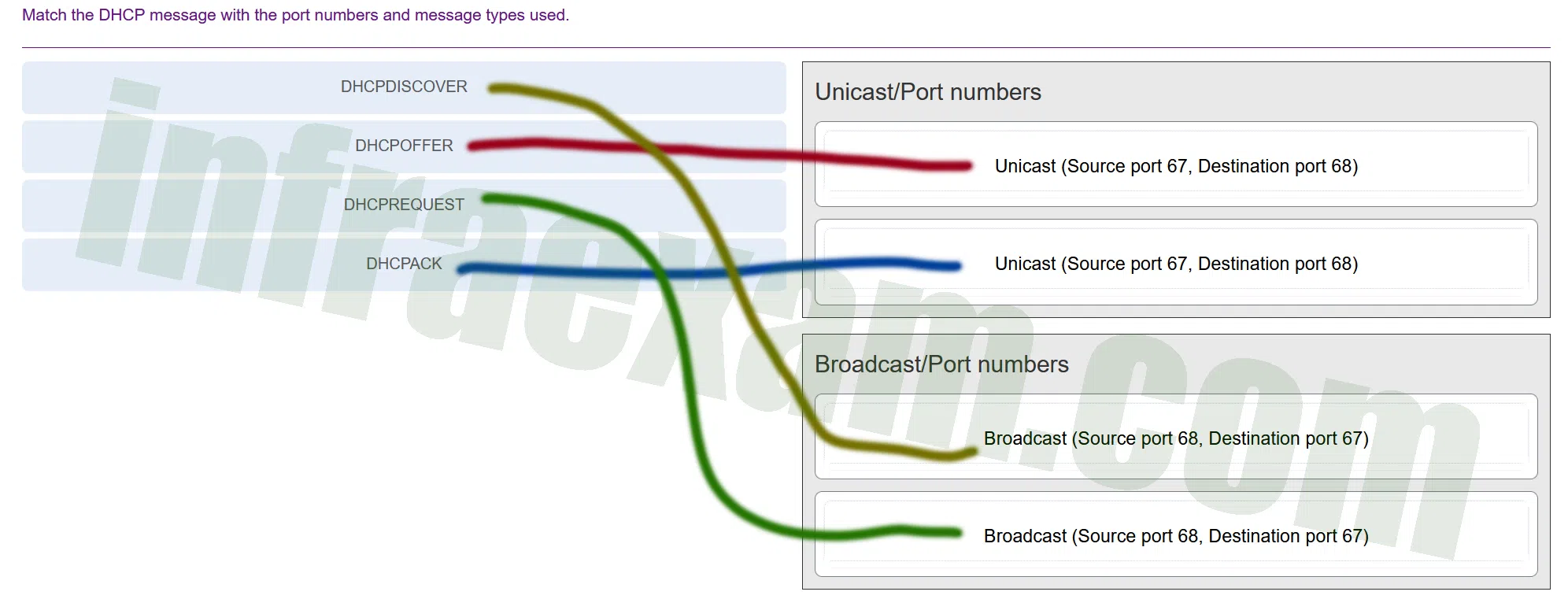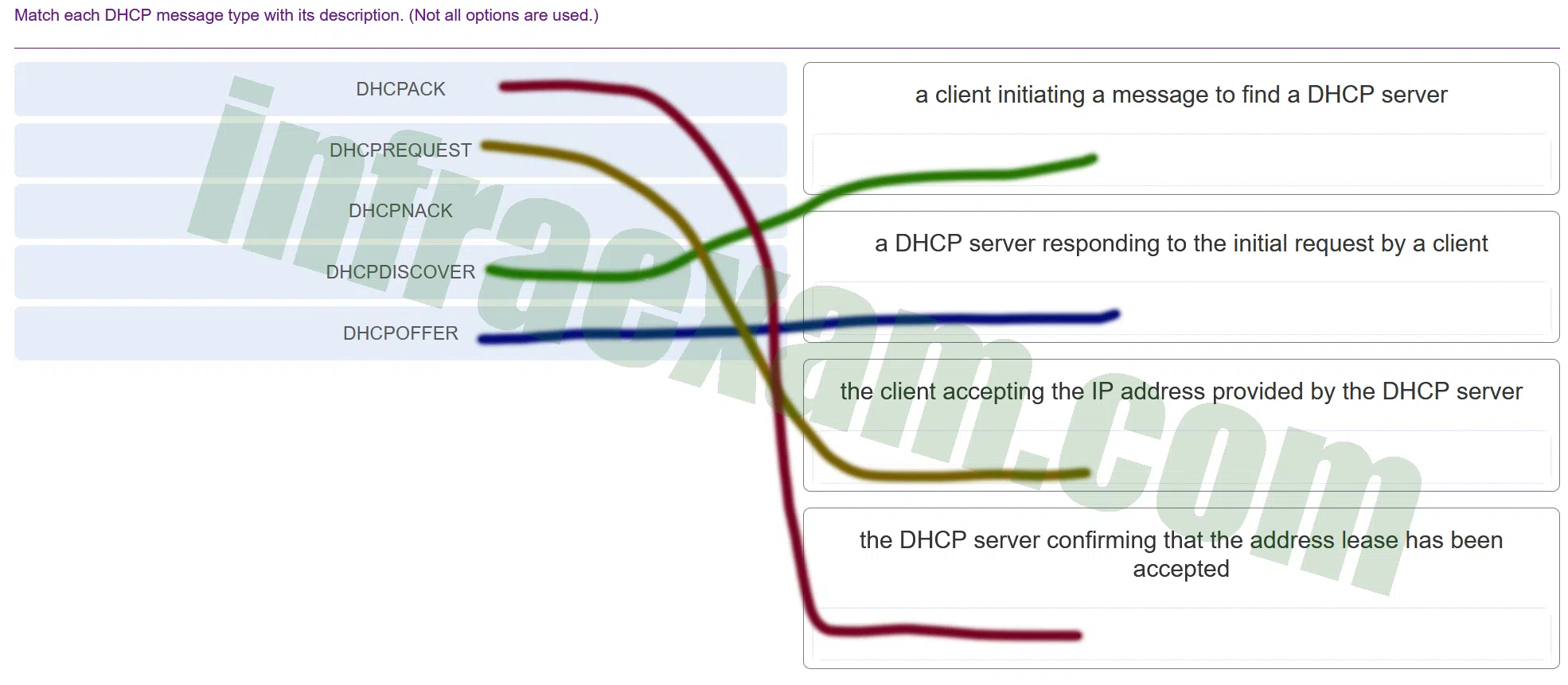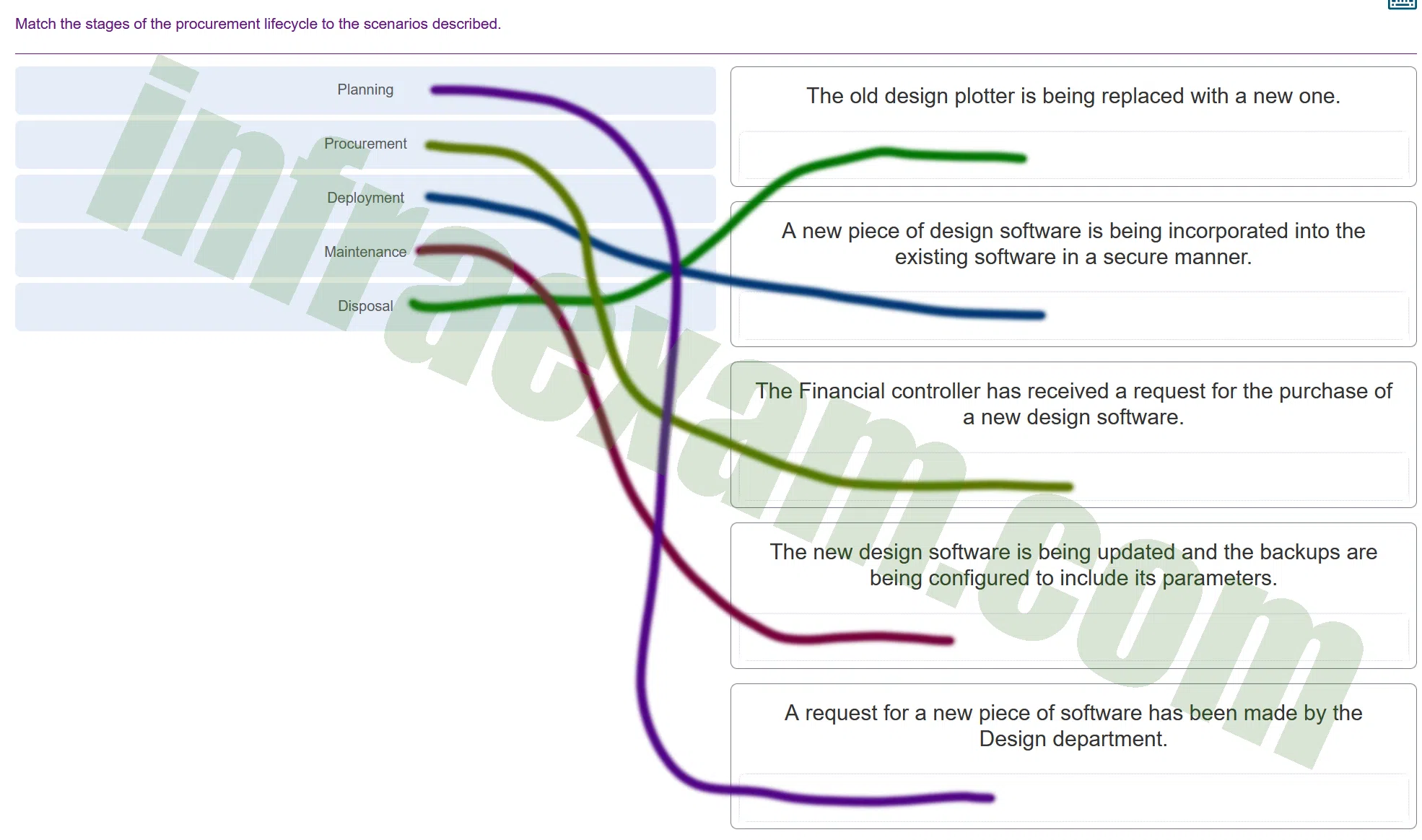IT Essentials 8.0 Bridge Exam Answers
IT Essentials 8.0 Bridge Exam Answers 2025
-
The acronym for putting out a fire using a fire extinguisher is PASS. What does PASS stand for?
- Pull, Accuracy, Squeeze, Spread
- Pull, Aim, Squeeze, Sweep
- Pin, Aim, Squeeze, Sweep
- Pull, Aim, Squeeze, Spread
- Pin, Angle, Squeeze, Spread
Explanation: The acronym PASS stands for:
P – Pull the pin.
A – Aim at the base of the fire, not at the flames.
S – Squeeze the lever.
S – Sweep the nozzle from side to side.
-
Match the type of Fire Extinguisher required for the type of fire described,
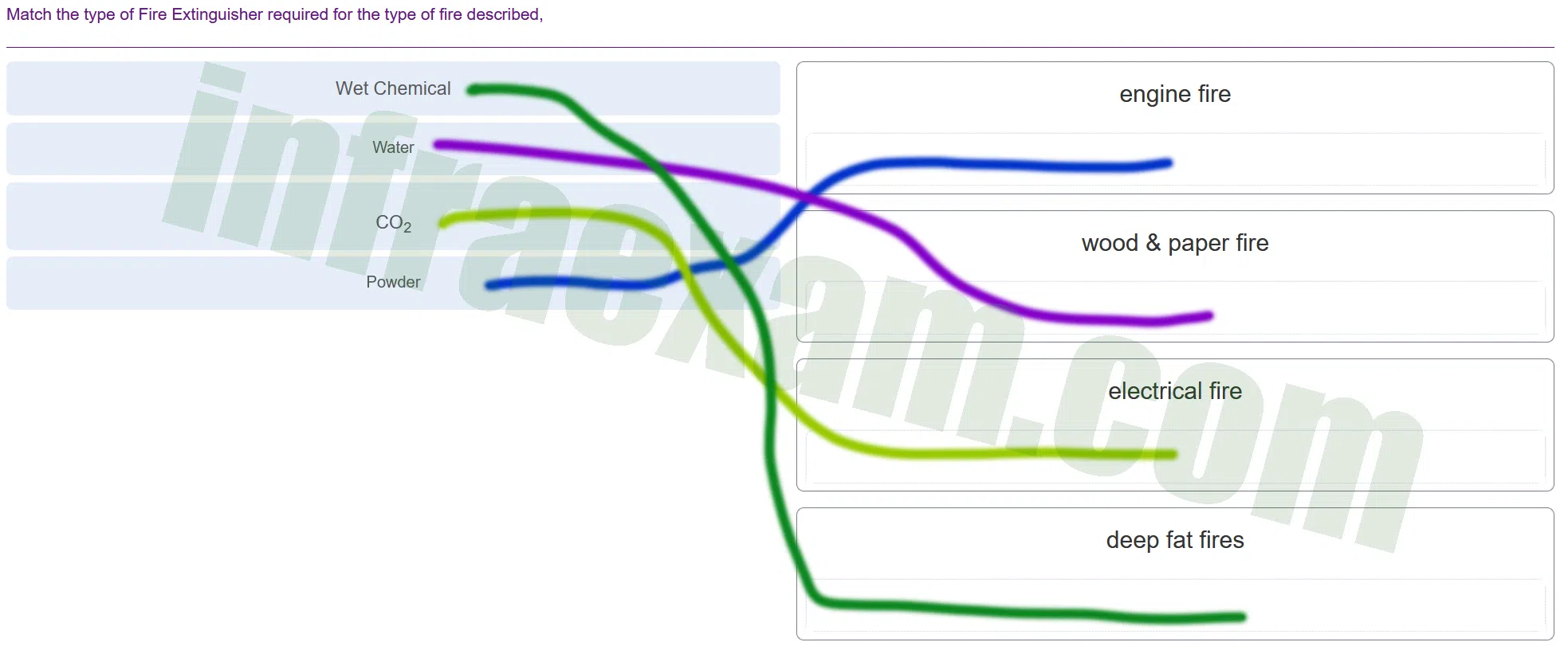
IT Essentials 8.0 Bridge Exam Answers Match 001 Explanation: The types of fire extinguishers and their use are:
- Water: solid combustibles such as wood, paper and textiles
- AFFF foam: flammable liquids
- Carbon dioxide (CO2) electrical equipment
- ABC powder: engines and electrical equipment located outdoors
- De-Ionized water mist: solid combustibles such as wood, paper and textiles, electrical equipment, and flammable liquids
- Wet chemical: deep fat fires
-
Match the resource record type with its use.
-
Which type of server keeps a list of domain names and their associated IP address information in resource records (RRs)?
- DHCP
- DNS
- WINS
- Domain controller
Explanation: A DNS server keeps a list of domain names and IP addresses information in resource records (RRs). This list of RRs is stored on a DNS server in a DNS zone database.
-
Which DNS SPAM Management feature uses an unencrypted RR to identify authorized servers permitted to send emails from the domain?
- AAAA
- SPF
- DKIM
- DMARC
Explanation: Sender Policy Framework (SPF) is a special TXT resource record that identifies authorized servers permitted to send emails from that domain.
-
Match the DHCP message with the port numbers and message types used.
-
What type of information is contained in a DNS MX record?
- the fully qualified domain name (FQDN) of the alias used to identify a service
- the IP address for an FQDN entry
- the domain name mapped to a mail exchange server
- the IP address of an authoritative name server
Explanation: A Mail Exchange (MX) resource record identifies one or more email exchange servers that are responsible for accepting email messages on behalf of a domain name.
-
Match each DHCP message type with its description. (Not all options are used.)
IT Essentials 8.0 Bridge Exam Answers Match 004 Explanation: Place the options in the following order:
- a client initiating a message to find a DHCP server – DHCPDISCOVER
- a DHCP server responding to the initial request by a client – DHCPOFFER
- the client accepting the IP address provided by the DHCP server – DHCPREQUEST
- the DHCP server confirming that the lease has been accepted – DHCPACK
-
Which three statements describe a DHCP Discover message? (Choose three.)
- The source MAC address is 48 ones (FF-FF-FF-FF-FF-FF).
- The destination IP address is 255.255.255.255.
- The message comes from a server offering an IP address.
- The message comes from a client seeking an IP address.
- All hosts receive the message, but only a DHCP server replies.
- Only the DHCP server receives the message.
Explanation: When a host configured to use DHCP powers up on a network it sends a DHCPDISCOVER message. FF-FF-FF-FF-FF-FF is the L2 broadcast address. A DHCP server replies with a unicast DHCPOFFER message back to the host.
-
What is the reason why the DHCPREQUEST message is sent as a broadcast during the DHCPv4 process?
- to notify other DHCP servers on the subnet that the IP address was leased
- to notify other hosts not to request the same IP address
- for hosts on other subnets to receive the information
- for routers to fill their routing tables with this new information
Explanation: The DHCPREQUEST message is broadcast to inform other DHCP servers that an IP address has been leased.
-
When an end device requests services from a DHCPv4 server it receives a host IPv4 address and a subnet mask. Which two other IPv4 addresses are also typically provided to a DCHPv4 client? (Choose two.)
- LAN default gateway address
- DNS server address
- LAN NTP server address
- local HTTP web server address
- automatic private IPv4 address
Explanation: LAN NTP server and local HTTP web server addresses are not provided by DHCP. Automatic private IPv4 addresses (APIPA) are used by DHCP clients when the clients fail to connect to a DHCPv4 server.
-
After cables were reconnected to a switch in a wiring closet, several PCs that had been previously configured manually can no longer access resources outside the local network. The PC configurations were not altered in the process and resources on the local network can still be accessed. What is a possible cause of the problem?
- The cabling to the PCs is faulty.
- The PCs are no longer on the correct VLAN.
- The DHCP server has been misconfigured.
- The DNS configuration on the PCs is incorrect.
Explanation: The PCs have been manually configured and confirmed to be correct, so DHCP and DNS configurations are not factors in this problem. The PCs can still access local resources, so there is not a cabling problem.
-
Which statement describes how hosts on VLANs communicate?
- Hosts on different VLANs can communicate using a layer 2 switch.
- Hosts on different VLANs communicate through routers.
- Hosts on different VLANs should be in the same IP network.
- Hosts on different VLANs can communicate using a wireless network.
Explanation: Traffic cannot pass directly to another VLAN (between broadcast domains) within the switch or between two switches. To interconnect two different VLANs, you must use routers or Layer 3 switches.
-
What is the function of the Secure Boot setting in UEFI firmware?
- it enables AHCI (Advanced Host Controller Interface) mode
- it allows for support of up to 2.2 terabyte hard drives
- it increases the boot upload speed
- it enables only Windows 8 or Windows 10 to be used as an operating system
Explanation: UEFI will check the boot loader before launching it and ensure it is signed by Microsoft (only supported by Windows 8 ,10 and 11). If a rootkit or another piece of malware does replace your boot loader or tamper with it, UEFI won’t allow it to boot. This prevents malware from hijacking your boot process and concealing itself from your operating system.
-
Refer to the exhibit. Which commands would the technician enter in Windows 10 PowerShell to determine the GUID of the GPT partition displayed?
IT Essentials 8.0 Bridge Exam Answers 01 - C:\WINDOWS\system32> diskpart
DISKPART> select disk 0 - DISKPART> list disk
DISKPART> select disk 0 - DISKPART> select disk 0
C:\WINDOWS\system32> sfc/scannow - DISKPART> select disk 0
DISKPART> uniqueid diskExplanation: You would use the following commands in order to determine the GUID of the GPT partition of a disk:
a. To determine your partition style:, right-click Start > select Windows PowerShell (Admin). Click Yes.
b. At the prompt, enter diskpart to start Microsoft DiskPart.
PS C:\WINDOWS\system32> diskpart
c. At the prompt, enter list disk to list all the disks on the system. The * under the Gpt column indicates that the disk uses Gpt for the partition style.
DISKPART> list disk
d. To determine the GUID of the GPT partition, enter select disk 0 at the prompt.
DISKPART> select disk 0Disk 0 is now the selected disk.
e. At the prompt, enter uniqueid disk to display the UUID of disk 0.
DISKPART> uniqueid disk
- C:\WINDOWS\system32> diskpart
-
A technician wants to upgrade several computers to Windows 10 over the network. Which of the following boot methods supports this upgrade method?
- PXE
- SSH
- HTTP
- HTTPS
Explanation: To be able to install Windows 10 from WDS (Windows Deployment Server) over PXE boot, your WDS server MUST have at least one install and one boot image. The boot image is what you will boot to from the Network while the Install image is the actual OS image you will install. You must also have a DHCP server with a scope configured for PXE.
-
A technician wants to upgrade a user computer to Windows 10 but keep the current settings and files intact during the new installation. Which upgrade method should the technician use?
- in-place upgrade
- clean install
- network install
- image deployment
Explanation: An in-place OS upgrade will start the upgrade setup from the existing OS and keep all the customized configurations and user data, and avoid reinstallation of all the applications and restoration of data.
-
What Windows Deployment Tool would a technician use to deploy applications to multiple computers across a given network?
- APIPA
- EFS
- Group Policy
- Local Security Policy
Explanation: Windows deployment tools, such as Group Policy, can be used to deploy the applications to multiple workstations from the server. An administrator sets up the installer packages and copies the packages on the shared network folder for distribution. The administrator creates Group Policy Objects (GPO) in the Group Policy Manager to deploy the application from the network shared folder to the target computers.
-
A technician is trying to upgrade a computer running Windows 10 Pro to Windows 11 Pro. The computer hardware specs are as follows:
512 GB SSD drive
8 GB RAM
a graphics card compatible with DirectX 12 or later with WDDM 2.0 driver
Trusted Platform Module (TPM) version 1.0.
Secure boot capable BIOS
Intel i7 Quad Core Processor
During the installation, the following message is displayed “This PC doesn’t currently meet all the system requirements for Windows 11”. What is the most probable reason for this?
- the Trusted Platform Module should be version 2
- Secure Boot has not been enabled in the bios
- the ISO is corrupt
- the PC is not connected to the internet
Explanation: While the requirement to upgrade a Windows 10 device to Windows 11 is only that the PC be Secure Boot capable by having UEFI/BIOS enabled, you may also consider enabling or turning Secure Boot on for better security.
The minimum requirements to upgrade a computer running Windows 10 Pro to Windows 11 Pro are:
Processor: 1 gigahertz (GHz) or faster with 2 or more cores on a compatible 64-bit processor or System on a Chip (SoC).
RAM: 4 gigabytes (GB).
Storage: 64 GB or larger storage device.
System firmware: UEFI, Secure Boot capable.
TPM: Trusted Platform Module (TPM) version 2.0.
Graphics card: Compatible with DirectX 12 or later with WDDM 2.0 driver.
Note- While the requirement to upgrade a Windows 10 device to Windows 11 is only that the PC be Secure Boot capable by having UEFI/BIOS enabled, you may also consider enabling or turning Secure Boot on for better security.
-
Where can you configure the recording time in Windows 10 in order to capture your game play?
- Start > Settings > Gaming > Xbox Game Bar
- Start > Settings > Gaming > Captures
- Start > Settings > Gaming > Game Mode
- Start > Settings > Privacy
Explanation: Windows 10 has integrated Game Bar settings. You can use it to adjust the length of recording time by going to Start > Settings > Gaming > Capture.
-
Which Windows 10 security feature helps to reduce the risk of malware exploiting the privileges of the Administrators group?
- EFS
- DNS
- UAC
- SFC
Explanation: UAC (User Account Control) is a security feature in Windows 10 that prevents unauthorized or inadvertent changes to the operating system. With UAC, apps and tasks always run in the security context of a non-administrator account, unless an administrator specifically authorizes administrator-level access to the system.
-
What happens when you are running a game in Windows 10 and have turned on the Gaming mode?
- prevents Windows Update from performing driver installations and sending restart notifications
- prevents the antivirus program from running in the background
- prevents Windows defender from running in the background
- gives 100% of the CPU cycle to the GPU
Explanation: When you use Game Mode, Windows prioritizes your gaming experience by turning things off in the background. When you’re running a game, Game Mode:
Prevents Windows Update from performing driver installations and sending restart notifications
Helps achieve a more stable frame rate depending on the specific game and system
-
A technician is setting up a booth at a company job fair. The technician needs to ensure job seekers can interact with the company application securely and limit all other activities on the laptop. The technician must also ensure that whenever the computer is rebooted or powered on it logs on automatically without a password. Which account type would the technician set up on this kiosk machine to do this?
- Guest
- Power user
- Standard user
- Administrator
Explanation: In Windows 10, the Guest account is a particular local user account with very limited permissions. It has the following restrictions:
It doesn’t have a password and passwords cannot be set for it.
It cannot install apps, desktop apps or hardware devices.
It can use only the apps and desktop programs that were installed on your PC or device when the Guest account was enabled.
It cannot change its account type, name or picture.
-
What is two-factor authentication (2FA)?
- two different authentication factors are used for verification
- two different passwords are used for verification
- the password undergoes two hashing functions
- two passwords undergo two separate hashing functions
Explanation: Two-factor authentication (2FA), sometimes referred to as two-step verification, is a security process in which users provide two different authentication factors to verify themselves.
-
Which two features in Microsoft Windows 10 require a user to input the Windows Hello Pin in order to set them up?
- Window Hello Fingerprint
- Window Hello Facial
- Folder encryption using EFS
- File encryption using EFS
- Windows PC Privacy Settings
Explanation: Windows Hello Fingerprint and Windows Hello Facial features require you to enter your Windows Pin in order to set them up.
-
Which security method in Windows 10 uses a single username and password once for multiple applications?
- SSO
- inheritance
- permission propagation
- EFS
Explanation: Single sign-on allows the users to access multiple applications with one username and password. The user only needs to remember one username and password, so they are less likely to lose or write down their credentials.
-
A user believes their gaming PC has been compromised because a gaming application provided location information. Which Windows 10 feature could be used to enable or disable the sharing of location information?
- account settings
- privacy and security settings
- gaming settings
- apps settings
Explanation: By providing the location information, it can enhance your gaming or mobile device experience; however, your location may become available to threat actors. You can choose which applications can access the location services by going to the Privacy & Security settings (choose the location tab and select which applications can be allowed to access the location services).
-
What action must be performed first when disposing of an asset that has reached the end of its lifecycle?
- find the appropriate waste disposal company
- destroy the asset
- sanitize any data contained in the asset
- donate or recycle the asset
Explanation: When an asset has reached end of life, the asset should be sanitized of any data. The sanitized asset can be sold, recycled, donated, or destroyed. The asset management database should be updated to reflect the change in the status of the asset.
-
Match the stages of the procurement lifecycle to the scenarios described.
-
What is an acceptable use policy?
- It is used to identify potential issues, provide insights for improvements, and take corrective action to prevent critical and major future incidents .
- It is a step-by-step instruction guide detailing how to access computers and networked services efficiently and securely.
- It is an agreement between two or more parties that defines the appropriate user access to resources or services.
- It is a centralized repository of articles and documents that allows the users to create, share, and manage knowledge across the organization.
Explanation: An acceptable user policy (AUP) is an agreement between two or more parties that defines the appropriate user access to resources or services. Before the users are granted access, the users must agree to the AUP and follow the policy outlined in AUP.
